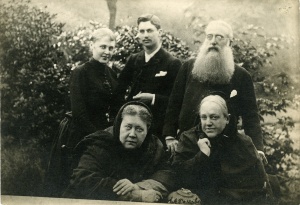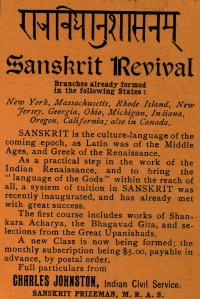Charles Johnston
Charles Johnston was a Sanskrit scholar and translator of several Hindu classics, and was married to H. P. Blavatsky's niece. He was a founder of the Dublin Lodge of the Theosophical Society of which William Butler Yeats and A.E. or Æ, as George William Russell was known, were also members. The Johnstons became members of the Theosophical Society in America headed by Ernest Temple Hargrove in New York.
Early life
Charles Johnston was born in Ireland, at Ballykilbeg, County Down, on February 17, 1867. His father was a prominent Orangeman, a Member of Parliament for Belfast and leader of the temperance movement. His mother was the daughter of Sir John Hay, a Scottish baronet. Johnston's education was at Derby, England, and later at Dublin University, where he became acquainted with the Irish poets William Butler Yeats and George William Russell, who became known as A.E. or Æ.[1]
As a 17-year-old, in November, 1884, Johnston read A. P. Sinnett's The Occult World, and the following year joined the Theosophical Society. When Madame Blavatsky was attacked by the Society for Psychical Research in the Coulomb affair, Johnston "made a vigorous protest in H.P.B.'s defence"[2] He read Esoteric Buddhism, Isis Unveiled, Light on the Path, and Five Years of Theosophy, and in 1887 met Madame Blavatsky in person. During his years at university, he had prepared for the Bengal Civil Service exam, which he passed brilliantly in 1888. In August of that year, he married Vera Vladimirovna de Zhelihovsky, daughter of Madame Vera Petrovna de Zhelihovsky and H. P. Blavatsky's niece. They had met while she was staying with her aunt in London. The ceremony took place at H.P.B.'s home, 17, Lansdowne Road, London. Col. Olcott, visiting London at the time, represented Vera's mother and the rest of the family at the civil marriage at the registrar's office.[3]
Shortly after the wedding, the Johnstons left for India, arriving in November. He contracted malaria, and became so ill that he was sent home after only two years in the position for which he had trained. In order to make a living he turned to writing for periodicals:
Teaching
Charles Johnston advertised a Sanskrit course on the inside back cover of Theosophy magazine in September 1897. It mentions classes formed in New York, Massachusetts, Rhode Island, New Jersey, Georgia, Ohio, Michigan, Indiana, Oregon, California, and Canada.[5]
Writings
Mr. Johnston translated many important Sanskrit works into English.
- The Bhagavad-gîta: "The songs of the master". Flushing, N.Y.: C. Johnston, 1908. Available online at Internet Archive.
- The Crest-Jewel of Wisdom by Śankarâchârya.[6]
- Yoga Sutras of Patanjali. 1912. Available online at Wikisource.
- Useful Sanskrit Nouns and Verb in English Letters. London: Luzac, 1892. Text available online at Internet Archive. Advertised on page 59 of Luzac's Oriental List and Book Review, Volume 4 by Luzac & Co., booksellers. Advertisement is available online at Google Books.
- From the Upanishads. Portland, ME: Thomas Mosher,1899. Available online at Internet Archive.
- Parables of the Kingdom.
- Memory of Past Births.
- Karma: Works and Wisdom.
- The Theosophy of the Upanishads.
- The Great Upanishads.
He also published several articles in The Open Court:
- "The Vedanta Philosophy" in February, 1906. Available at OpenSIUC.
- "The Kingdom of Heaven and the Upanishads" in December, 1905. Available at OpenSIUC.
- "The Childhood and Youth of St. Paul" in April, 1911. Available at OpenSIUC.
Notes
- ↑ H. B. M.[Henry Bedinger Mitchell] "Charles Johnston", The Theosophical Quarterly 29.3 (January, 1932), 214.
- ↑ Charles Johnston, The Theosophical Quarterly 29.1 (July, 1931).
- ↑ Henry Steel Olcott, Old Diary Leaves Fourth Series (Adyar, Madras: The Theosophical Publishing House, 1974), 71.
- ↑ H. B. M.[Henry Bedinger Mitchell] "Charles Johnston", The Theosophical Quarterly 29.3 (January, 1932), 207.
- ↑ "Sanskrit Revival" advertisement in Theosophy 12.6 (September 1897).
- ↑ Sankaracharya, The Crest-Jewel of Wisdom (Vivekachudmani), translated by Charles Johnston, available at Theosophical University Press Online Edition [1]

